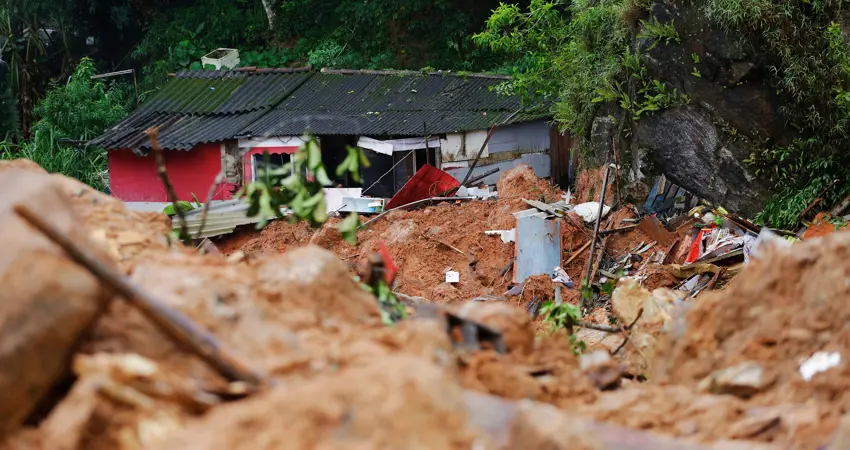20 May 2024
Man-made climate change likely to have contributed to Brazil landslides in 2020, study finds
20-42% of the total socioeconomic losses and damages caused by the extreme rainfall and landslides can be attributed to man-made climate change, according to a paper published in Natural Hazards this month

A house stands damaged by a landslide caused by heavy rains in the southeastern coast of Guarujá, São Paulo state, Brazil.
Natural disasters such as floods and landslides triggered by extreme rainfall have caused hundreds of deaths and injuries, and caused economic losses and damages totalling millions of dollars every year. In Brazil an extreme weather event in March 2020 deposited between 330mm of rain in Santos, a town in the Baixada Santista region, with the 48 hour rainfall total exceeding the usual amount for the whole of March.1
Coupled with high rainfall in the preceeding months and geological characteristics of the area this event led to a disastrous sequence of landslides, affecting more than 2,800 people, destroying over 4,500 dwellings and with estimated economic losses exceeding USD $43 million.
Previous studies have shown the Baixada Santista area’s increasing vulnerability to climate change, with 8.2m people in regions exposed to risk of floods, flash floods and land movements. A new attribution study recently published in Natural Hazards aimed to explore how much this could be attributed to climate change. Attribution is a method to estimate how much human influence on the climate has changed the likelihood of extreme events, using a combination of the latest observations and cutting-edge computer simulations.
The aim of the study, carried out by climate scientists and researchers at the University of Oxford, the Met Office, the Universidade de São Paulo, the National Centre for Monitoring and Early Warning of Natural Disasters (Brazil) and Charles University (Prague), was to focus on landslide-triggering heavy rainfall events and to assess the change in occurrence and intensity of heavy rainfall due to anthropogenic (man-made) climate change.
Focusing on three municipalities of the Baixada Santista: Santos, Guarujá and São Vicente, the most affected cities during the event, the study found that human-induced climate change increased both the 60-day total rainfall (setting up the possibility for landslides) and the three day total. The studies also suggest that the frequency of these events is likely to increase in the future.
Co-author Dr Sarah Sparrow, climateprediction.net Programme Coordinator at the University of Oxford's e-Research Centre, says, “Directly attributing climate change impacts on landslides is a big challenge as they are highly dependent on local characteristics. However by focusing on the changes in rainfall during the workshop analysis we were able to start to address this question and show that climate change is already increasing the likelihood of landslide triggering rainfall in Baxiada Santista.” Dr Sparrow organised the workshop in September 2022 that focused on the landslide-triggering heavy precipitation in Brazil.
The findings are useful in producing Policy Briefs and recommendations for local authorities to implement measures adapting to climate change in high-risk areas, including establishing early warning systems and evacuation plans during extreme weather events, ensuring that emergency services are equipped to deal with the increased frequency and severity of such events, and regulating building in high-risk areas.
1 In Santos, the 48 h rainfall total surpassed the 2014–2022 climatological accumulated precipitation of the whole March, of 313 mm (Cemaden gauge data for Nova Cintra Station)
Natural Hazards Article - Extreme rainfall and landslides as a response to human-induced climate change: a case study at Baixada Santista, Brazil, 2020




